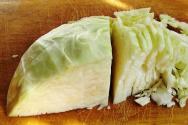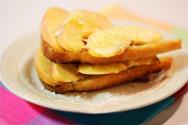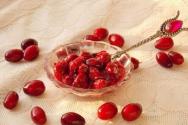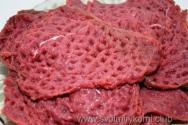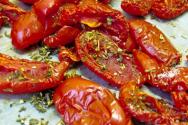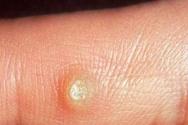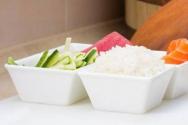What kind of shortbread dough is there? Shortbread dough for pies and cookies. Options and Supplements
This is an intermediate option between sand and puff pastry. It is crumbly but firm, making it suitable as a base for large pies and quiches.
In a recipe, you can add the word “cold” before each ingredient and item, and this should not be neglected. The water should be ice cold and the oil should be rock hard. Bowls, knives and even the board on which you will work with the dough are good to keep in the freezer. It is better to move the cutting table away from the radiator or open the window.
Secret shortcrust pastry In oil. It is thanks to him that the baked goods turn out crumbly.
All this trouble to prevent the butter from melting. Because otherwise you will get a completely different product.
Classic way
Ingredients
- 200 g butter;
- 300 g flour;
- a pinch of salt;
- 50–100 ml of water.
Preparation
Cold butter chop into small cubes and place in the freezer for 15 minutes. At this time, sift the flour and salt and pour it onto the table or board. Place the butter cubes on top, sprinkle them generously with flour and use a knife or two to cut into the dough.
It is important to touch the oil with your hands as little as possible: body heat will quickly melt it, and the consistency will not be what you need.
When the butter and dough come together and turn into small grains, add water little by little, kneading the mass into a plastic ball. Place it in the freezer for 15 minutes. Then roll out the dough, put in the filling, for example, and put it in the oven.
Lazy way
Technological progress does not stand still, why not use it in cooking. You will need the same ingredients and a food processor with blades. It is not necessary to chop the butter into small cubes: the device will handle it itself. Place butter and flour in a bowl and whisk. The main thing is not to overdo it; in the end you should get the same grains.
Gradually add ice water until the dough begins to come together into a ball. The following instructions are the same as in classic recipe.
Shortbread dough Can be stored in the freezer for several weeks.
Supplements
You can deviate from the basic recipe. Here are some ideas:
- Place 50–100 g of sugar into the sweet pie dough.
- Replace 30 g of flour with the same amount of cocoa - you will get chocolate dough.
- Add up to half a glass of finely chopped nuts.
- Flavor the mixture with citrus zest or vanilla.
This recipe will yield a more flexible dough that is easier to roll out. Baked goods made from it crumble less. By the way, in culinary disputes, some confectioners refuse to call chopped dough shortbread. They believe that only with the help of such a recipe can they get classical basis for tarts and baskets.
The oil should not be cold, but chilled. It is impossible to explain how one state differs from another. Just remove the product from the freezer an hour before cooking.
Ingredients
- 100 g butter;
- 100 g sugar (better - powdered sugar);
- 250 g flour;
- 1 egg (or 2 yolks).
Preparation
It is better to mix the ingredients with a spatula or spoon, and use your hands only at the last stage, when you need to gather the dough into a ball. Cream butter and sugar, add flour, then egg.

If you have a food processor, delegate all these responsibilities to it.
You can chill the dough and then cut it. You can first give it the desired shape and then put it in the freezer. It is important that it goes into the oven cold.
3. Curd shortbread dough
This dough is less finicky to work with than its counterparts without cottage cheese, and has less calories, since fermented milk product replaces half the oil.
Ingredients
- 100 g cottage cheese;
- 100 g butter;
- 180 g flour;
- ½ teaspoon of soda;
- ½ teaspoon salt.
Preparation
Rub the cottage cheese through a sieve, grate the cold butter. Mix both ingredients with a fork, add flour, soda and salt. Quickly knead the dough until smooth, put it in a bag and put it in the refrigerator for an hour.
What to do next
If there is a pie on the menu, roll out the dough to the size of the mold, pierce it several times with a fork to prevent it from swelling, cover with parchment paper and cover with a weight. Special heat-resistant balls or beans or peas can be used as a weighting agent. This design is baked for about 15 minutes at 180 °C. Then remove the weight, add the pie filling and cook until done.
It is better to choose the filling adjusted for the sugar content in the dough. Unsweetened chopped is suitable for quiches with filling, pies with meat and vegetables. Dough with added sugar will be the basis for fruit and berry
Baskets are baked in the same way, only the cooking time must be reduced in proportion to the reduction in the size of the cakes. It is enough to bake cookies and other small products in the oven until lightly browned, otherwise they will be too hard.
Shortbread doughWe are somehow accustomed to the fact that there is only one shortbread dough, there are simply different numbers of recipes that give us different final results. But, in fact, shortcrust pastry is divided depending on the texture and filling that we want to use.
I’ll be honest, when studying the material, I got confused in the terminology, since my source is aimed at American and European users. Therefore, I will write to you both the French and English versions of the name, so that it is clear what we are talking about.
I would also like to note that each pastry chef chooses his own method of performing the dough. Therefore, the main thing is to understand the principle and the end result. And the ratio of different products may vary depending on the recipe and the pastry chef.
Shortcrust pastry is the most used. It keeps well for several days in the refrigerator and several months in the freezer.
Shortbread dough gets its strength from the gluten in the flour and its tenderness from the fat.
The amount of water in the dough is key point, since water promotes the formation of gluten when mixing flour and water. Too much water and the dough will be hard and dry, c Using too little liquid will make the dough crumbly and difficult to work with.
The usual rule:should be addedenough water to allow the flour and shortening to combine and hold its shape when pressed with your fingers.
Types of shortcrust pastry

The terms “pie” and “tart” are often used in literature. For a long time I asked myself how they differ. Found the answer on this website. Many thanks to Elena for a detailed analysis of this issue.
This is what happens. In Russian tradition, by pie we mean yeast dough with filling (sweet, meat, fish).
Pies are very popular in America. (
pies).
It's basically chopped dough as a base and lots of filling. The dough serves as a “container” for the filling. Therefore, it is prepared simply from flour, oil and water. But there will be a lot of fillings for this dough (berries, cream, fruit). Often the pies are closed or made into a lattice of dough. Sweet shortbread dough is rarely used.
Rarely found in Europe closed pies, most often these are open tarts (
tarts).
Tart dough is also made from chopped dough, but eggs are added instead of water. But more often they use sweet shortbread dough - different variants (Pâ
te Sucré
e,
Pâ
te Sableé
e).
Europeans believe that the dough itself should also play a role in imparting flavor, not just the filling. As a rule, tarts are smaller in height, thinner, and contain less filling. Yolks, eggs, nut flour, more sugar and butter are added to the dough to give it more taste.
Let's look at the main types of test.
1.
Pâ
te Brisé
e(chopped shortbread dough,
rubbed dough)
Means “broken dough”, butter and flour are mixed first - this technique is called sablage or the grinding method ( sanding method ). Fat and flour are ground to crumbs ( meal or sand ). When flour is coated with fat, it protects the flour from absorbing water and developing gluten. The result is tender dough. AlsoPâ
te Brisé
e -
This is a pie or tart dough that is made without sugar.
Typically used for quiches, savory tarts and pies, and large tarts.
In American confectionery, chopped dough is divided into 2 types: puff pastry for the pie (
flaky pie dough)
Andmealy pie dough).
Cpuff pastry for pie (
flaky pie dough) -
This is a chopped dough where butter and flour are chopped with a knife until the butter is the size of lentils. The larger the fat before adding the cold liquid, the flakier the dough will be and the crispier it will be after baking. Once the dough comes together into a ball, chill it in the refrigerator.
Puff pastry is very good for pies and tarts with fillings that are baked directly into the base. It is not suitable for pies and tarts, in which you need to bake the base, let it cool and pour in the liquid filling and let it set in the refrigerator. After baking, it is easy to get into the holes that appear in the layered structure. liquid filling and may leak from the base.
When butter and flour are ground into coarse crumbs, the result is crumbly pie dough (
mealy pie dough).
This dough has a softer texture than puff pastry pie dough. Since fat is more evenly distributed in flour, it is able to reduce ( shorten ) gluten threads in the dough. The result is a very tender dough. The dough should also be placed in the refrigerator to allow the gluten to rest and relax. And then you can roll it out.
Crumbly pie crust works well for pies and tarts, but is especially good for recipes where you bake the crust first and then fill it with prepared filling. It is also good for bush tarts. Since the fat particles are evenly distributed throughout the dough (unlike flaky pie dough ), and they form a barrier that prevents the base from getting wet quickly.
2.
Pâ
te Sucré
e(sweet shortbread dough,
short dough) -
sweet dough similar to P â te Bris é e , but containing large amounts of sugar. The high sugar content serves as a softener, so this dough is brittle and more difficult to work with than P â te Bris é e . It is used mainly for tartlets and privers. P â te Sucr é e can be prepared using the grinding method ( sablage ), and by the beating method. The creaming method, in which the butter and sugar are creamed first, is also used to make cookies, cupcakes, and muffins. Also sweet dough P â te Sucr é e and P â te Sabl é e can be used to make cookies.
P â te Bris é e and P â te Sucr é e known as 1:2:3 dough, although formulas vary.
Pâ
te Sucré
e consists of from 1 part sugar: 2 parts fat: 3 parts flour.
Pâ
te Brisé
e consists of 1 part liquid (usually water): 2 parts fat: 3 parts flour
3. Pâ te Sableé e contains more fat than P â te Sucr é e And less eggs and other liquids. Some formulas also contain more sugar. This is a very tender and crumbly dough that is usually used for cookies and small tarts. This is shortcrust pastry sable means sand. Can be prepared by grinding and beating method. A softer and more crumbly base is formed.
Shortcrust pastry is very easy to “overwork” (mix) and it will become tough and hard as gluten develops. When working with shortcrust pastry, mix in a mixer at low speed, after adding liquid, bring to the point where the dough begins to form into a ball, stop and assemble with your hands. Wrap in cling film and flatten into a rectangle. Chill in the refrigerator for at least 2 hours. If the volume of dough is small, then it is more convenient to do everything with your hands, since you can better feel the texture of the dough with your hands.
I used to use butter, which was a little soft in the refrigerator. And then, after writing a post about fats, I started using only 82.5% oil and always take only solid oil. I use Valio and really like it. If you use soft butter, then after removing it from the refrigerator it quickly begins to melt and it becomes difficult to roll it out. With hard butter, everything works out great - it hardens well. It is better, of course, to keep the dough in the refrigerator overnight, but 2-3 hours is enough to take it out of the refrigerator and easily roll it out to a thickness of 3 mm.
When working with the dough, you need to lightly dust the table with flour, but do not overdo it, as the dough may become hard. If you see that the dough has begun to melt, it is better to place it between two parchments and cool it, and then roll it out to the desired thickness.
For tarts and tartlets, cut out circles (squares) 2 cm larger than the shape where you are going to place the dough. Carefully lower the dough down and push it slightly so that at the bottom it forms a right angle with the mold. Cut off the excess dough with a knife. Pierce the bottom with a fork and place in the refrigerator to cool for 30 minutes. You can put it in the freezer for 15-20 minutes.
Then place the weight and bake until the edges are browned, remove the weight and bake until golden brown. You can bake well-chilled tarts and tartlets without a load, but then the bottom may rise a little. I like it better with a load, although it takes a little longer.
Shortbread dough can be stored in the refrigerator for several weeks (it lies quietly for 2 weeks), and in the freezer for up to 2 months.
Shortbread dough is baked at a temperature of 163C-219C. 190C is considered ideal.
According to the kneading method: in various books and websites they write that shortbread dough should be kneaded only with cold butter, others - only with soft butter. You can knead it either way (except for Brize dough), it all depends on what texture you want to get and what filling to use. If you want a crispier texture, then it is better to use the method of grinding butter with flour, but if you want a crumbly, tender texture, then use the whipping method.
In fact, working with shortcrust pastry is a lot of fun. Especially after knowing about different products and the properties of the ingredients in the dough, the sequence of actions already becomes clear and logical.
Sources:
Bo Friberg The professional pastry chef. Fundamentals of baking and pastry. - John Wiley & Sons.Inc, New-York, 2002.
Baking and Pastry: Mastering the art and craft by The Culinary Institute of America - 2nd ed.
The fundamental Techniques of classic pastry arts - the French Culinary Institute
Wayne Gissen Professional baking - John Wiley & Sons.Inc, New York, 6 ed. 2013.
Delicate and crumbly products are obtained from shortcrust pastry, but only if it is mixed correctly. To prevent cookies or cakes from being hard, you need to know some of the intricacies of making shortcrust pastry. We'll talk about this below.
Recipe contents:
Products made from shortcrust pastry always turn out crumbly, because... contain a lot of fat, like butter or margarine. This is exactly what it is distinctive feature dough, which is why it is called shortbread. It is prepared easily and quickly, the main thing is to follow certain rules.
Secrets of making shortcrust pastry
- So, the first secret is the temperature of the ingredients. The butter should be cold and firm, not frozen. Other foods should also be kept at a cold temperature.
- The crumbly effect will only be achieved thanks to a large amount of oil. Therefore, there is no need to feel sorry for him.
- The flour needs to be sifted and rubbed with butter until it reaches the consistency of crumbs. It is important! The fat coats the flour. Gluten in flour combines with moisture and creates crunch, crumbliness and softness, rather than elasticity.
- Keep the proportion of flour and butter - 1:2. Then there will be a pleasant result.
- The dough is kneaded by hand and not for long. Otherwise, the butter will melt, which will prevent the products from coming out tender and soft.
- It is easier to roll out the dough after cooling for half an hour in the refrigerator. It will compress and shrink.
- The products are baked in a preheated oven at 180-200 degrees.
- See the recipe -
- Calorie content per 100 g - 314 kcal.
- Number of servings - 700-800 g
- Preparation time: 15 minutes for kneading, 30 minutes for cooling
 Ingredients:
Ingredients:
- Flour - 500 g
- Eggs - 1 pc.
- Butter - 250 g
- Sugar - 1 tbsp.
- Salt - a pinch
- Baking soda - 1 tsp.
Step-by-step preparation of shortcrust pastry:

1. Cold-temperature butter, not frozen, cut into pieces.

2. Combine the butter with the flour sifted through a sieve.

3. Using a knife, quickly cut in the flour to form fine flour crumbs. Add soda, salt and sugar and continue moving the knife so that the products are evenly distributed.

4. Make a small well in the flour crumbs and crack the egg into it.

5. Stir the mixture with a fork or knife so that the egg is evenly distributed throughout the mixture.

6. Knead the dough with quick movements, gathering it into a lump. Here, in fact, you don’t need to knead anything, just rake the dough from the edges to the middle, forming it into one whole “ball”.

7. Wrap the dough in plastic and refrigerate for half an hour, or better yet, an hour. The dough can be kept in the refrigerator for 1-2 days. It can also be frozen for up to 3 months.
After a certain time, you can start baking cookies, pastries, pies. But keep in mind that since the dough contains a large amount of fat, the board and rolling pin for rolling must be chilled, so I recommend keeping them in the refrigerator for some time in advance. It is also important to roll out the dough very quickly, because... it must not be allowed to warm up.
Note: the dough can be given a special taste and aroma. To do this, vanilla sugar, grated lemon or orange zest, crushed chocolate, cocoa powder, ground or chopped nuts, cinnamon, etc. are added to the composition. Additives should be added when kneading the dough and cooled with them in the refrigerator.
Today we will talk about all types of crumbly dough, which are usually called “short”, “chopped”, “sugar”. They make wonderful cookies, tartlets and all kinds of pies.
The composition of all these types of dough is the same and simple: flour, butter, a small amount of liquid and a pinch of salt, and, if necessary, sugar or powdered sugar. However, different ratios of ingredients, the introduction of additional flavors and aromas, as well as changes in the way the products are combined allow you to obtain dough with different tastes, textures and properties.
Secrets of making shortcrust pastry
Flour, which we use to prepare crumbly dough, should not be high in protein. In our reality, this is ordinary flour. premium. 30% of the weight of flour required for the recipe can be replaced with corn, rice, rye, buckwheat or whole grain wheat flour, oatmeal, ground nuts or cocoa. This substitution will make the dough more crumbly and complicate its taste.
Butter must be of good quality with a fat content of at least 82%. The proportion of butter in the dough is quite large, and it is its taste that determines the taste of the finished pie. Some recipes use beef tallow instead of butter. This dough is both dense and crumbly.
UNTIL FLOUR AND LIQUID HAVE MEETED IN THE DOUGH, YOU CAN STIR IT, WHIP, KNEAD IT, BUT AS SOON AS THE LIQUID IS ADDED, KNEADING THE DOUGH MUST BE COMPLETED AS QUICKLY AS POSSIBLE, OTHERWISE IT WILL BECOME HARD.
The flour to butter ratio varies from recipe to recipe and usually ranges from 1:1 (equal parts flour and butter by weight) to 2:1 (twice the flour and butter). The higher the oil content, the more crumbly and tender the dough will be. This factor is especially important to consider when choosing a recipe for the base of an open pie: a dough that is too crumbly will not hold a heavy and/or bulky filling. 
Amount of sugar in crumbly dough is determined mainly by the filling with which this dough will be combined. Perhaps this is the only type of dough whose sweetness can be adjusted to your taste without the risk of hopelessly spoiling the finished product. In pie dough with unsweetened filling You don't have to add sugar at all. In some recipes, the sugar content can be up to 80% of the flour weight. Excess sugar makes the dough too brown and tough.
Dark or light cane sugar gives the dough not only sweetness, but also a molasses aroma. In any case, it is advisable to use sugar with small crystals. Powdered sugar is often used instead of sugar. It makes the dough softer and at the same time denser.
Liquid used in quantities necessary and sufficient to bind the dough together.
The role of liquid can be given to water, eggs (whole egg, white only or yolk only), milk and almost all dairy products: cream, buttermilk, sour cream, etc. At the same time, you need to understand that egg yolk it is mostly fat and the protein is water. And the more “fatty” the liquid, the more rich the dough turns out. That is, dough made with water is denser and simpler in taste than dough made with yolk and milk.
Salt necessary as a “unifier of tastes”, don’t forget about it! It is advisable to use fine salt.
Cream dough. This is the most tender of all possible thanks to the almost complete absence of water and the presence of fat. This dough retains its shape well when rolled out.
Dough with sour cream. It is a light textured dough with a buttery flavor. The acid contained in sour cream softens the gluten, making the dough less elastic and more crumbly; it does not shrink as much when baking. To prepare this dough, replace the water with an equal amount of sour cream.
Yogurt dough. Light, crumbly, tender, with the sourness of yogurt.
Shortbread dough kneading technique

To prepare crumbly dough, butter is mixed with flour in the form of tiny particles, no matter how it is done.
Fat quickly envelops the flour particles, almost completely blocking the formation of gluten, and since there is relatively little liquid for the development of gluten in butter and eggs, it turns out to be quite weak. The result is a crumbly dough.
There are mainly three methods of kneading crumbly dough:

Cream method
Result. The dough mixed in this way turns out really “sandy”. When the finished product is broken, a homogeneous structure with small pores is visible, and if you press on a piece of such dough, it will crumble into small crumbs of grains of sand.
Equipment. You can knead with a spoon, mixer or food processor.
Application. This dough is used to make cake layers, as a basis for sweet pies with light filling, for making cookies.
Butter should be room temperature. This means that it needs to be removed from the refrigerator about an hour before cooking. During this time, the butter will become pliable when pressed with a spoon, but will not lose its shape (will not float).
It is also better to remove the eggs from the refrigerator an hour before cooking, then they will quickly and evenly combine with the oil.
This dough keeps well in the freezer. Knead a large portion at once conveniently when ready dough is at hand.
If you take the same set of products, but combine them different ways, the dough will vary in texture. However, whatever method you choose, remember: you don’t need to knead the dough for a long time and thoroughly! As soon as the dough comes together in a ball and does not fall apart, it can be considered ready.
Italian way
Using this method, you can prepare crumbly dough according to any recipe.
Result. The dough prepared in this way is elastic, strong, and quite easy to roll out. This is the strongest of all types of crumbly dough.
Equipment. Stand mixer or electric mixer with paddle attachment.
Application. As a base for sweet pies in which the filling is closed with a lattice (“semi-closed”), for sweet pies with a heavy filling, for baskets, as well as for the preparation of so-called “free-form pies”.
Pay attention to the temperature of the oil: it should be cold, but not too cold. freezer, and from the refrigerator. The cubed butter should retain its shape, but when pressed with a knife, the cube should flatten easily. Under no circumstances should the butter have the consistency of sour cream! 
Chopped dough method
In this method, flour is "chopped" or rubbed with cold butter until crumbs form, then liquid is added and the dough is quickly kneaded.
If the crumbs are small, like bread crumbs, the dough will look like shortbread. If the crumbs are the size of a pea or small beans - more
layered. The combination of small and large pieces will give an interesting layered sandy texture.
Chopped dough can be either savory (brize) or sweet (sugar dough).
Result. Products made from dough mixed in this way are not only tender and crumbly, but also slightly flaky.
Equipment. Food processor or knead by hand.
Application. This dough is used as a base for open pies and tarts.
The butter, liquid and eggs (if used) should be cold from the refrigerator.
Types of shortcrust pastry
Sweet shortbread dough
For 2 pie bases with a diameter of 22-24 cm:
1. Remove the butter from the refrigerator about an hour before cooking so that it becomes pliable when pressed with a spoon.
2. Place the butter in a bowl, add sugar and rub until light cream.
3. Stir the egg and yolk into the butter mixture until the eggs and butter are completely combined.
4. Sift the flour with salt and add to the butter-egg mixture. Knead the dough quickly. If you are using a mixer, keep it running on low speed.
5. Once all the flour has been combined with the butter-egg mixture, the dough is ready. It turns out very soft, it is impossible to roll it out without preliminary strong cooling.
Pie dough
For 1 half-closed pie with a diameter of 24-26 cm:
1. Cut the butter into 1 cm cubes.
2. Place sifted flour, salt and sugar in a mixer cup.
3. Set the mixer to low speed.
4. At the moment when the butter is almost rubbed into flour, stop beating.
5. Put sugar in the bowl and beat a little more until the sugar dissolves.
6. Add the butter-flour mixture and eggs and stir until smooth, 5 seconds.
7. Place the dough on the table, knead 2-3 times. Shape the dough into a round shape and refrigerate for an hour.
Sweet chopped dough (sugar)
For 1 open pie with a diameter of 26-28 cm:
1. Cut the butter into pieces of any shape.
2. Sift the flour into a bowl or onto a work surface and sprinkle with sugar and salt.
3. Place pieces of butter on the surface of the flour mixture. Using your fingertips, rub the flour into the butter until fine crumbs form.
4. Collect the crumbs in a heap, make a “well” in the middle and pour the yolk and 1 tbsp into it. l. milk. 
5. Using your fingertips, mix the ingredients into soft dough and collect into a ball. If the dough crumbles, add another 1 tbsp. l. milk. Knead the dough 2-4 times until it becomes homogeneous. Form into a ball, flatten into a disk, wrap in cling film and refrigerate for at least 30 minutes, preferably 4 hours.
Unsweetened chopped dough (breeze)
For 1 open pie with a diameter of 24-26 cm:
1. Place a dough cutter (plastic or steel) into the bowl of the food processor. Cut the butter into small pieces.
2. Sift flour and salt into a bowl. Add the butter and, turning the food processor on and off several times for 2-3 seconds (pulse mode), chop the butter and flour into crumbs.
3. Add the yolk and milk. Turn on the processor until the dough comes together into a ball. This will happen literally in 1 minute.
4. Transfer the ball of dough to a work surface, flatten into a disc, wrap in cling film and refrigerate for at least 30 minutes.
The dough can be kneaded by hand, following the sequence described in the sweet chopped dough recipe.
Working with ready-made dough
As a rule, it is recommended to put any crumbly dough in the refrigerator for at least 30 minutes before baking. During cooling, the small amount of water that is in the dough will be evenly distributed, the gluten will soften and “relax”, due to which the dough will become more elastic and pliable and will not shrink from the heat of the oven. You can chill the disc of kneaded dough, or you can form a pie base and put the dough pan in the refrigerator. It is especially important to refrigerate doughs with a high oil content.
To form the base for the pie, do one of the following:
1. Wet your hands cold water. Pinch off small pieces of dough and “glue” them to the bottom of the pan. Start from the middle of the mold and gradually move towards the sides. Make sure that the dough is the same thickness everywhere. When the bottom is closed, start forming the sides.
When the sides of the pan are also covered with dough, run your thumb or forefinger along the entire perimeter of the bottom, pressing the dough. Then the layer of dough at the junction of the bottom and sides of the mold will not be too thick.
2. Roll out the dough on a work surface and transfer it to the pan.
How to roll out the crumbly dough and put it into a mold:
1. You can roll out the dough on a floured work surface. However, additional flour can make the dough rougher, and it is not always possible to shake it off the dough. Therefore, it is convenient to roll out the dough between two sheets of baking paper or cling film. In addition, in this case it is much more convenient to turn the dough. You can also transfer the dough into the mold on paper or film: remove the top sheet of paper, transfer the dough into the mold, turn it over so that the paper is on top, and remove the second sheet of paper or film.
2. Do not roll out the dough by moving the rolling pin back and forth. Start from the center - move up. Move the rolling pin to the center - downward motion. To the center - to the left, to the center - to the right. Continue rolling out the dough to the desired thickness.
3. Try to ensure that the size of the rolled dough layer is 4-5 cm larger than the size of the mold. Then the dough will freely cover both the bottom and sides of the mold, and the excess can always be trimmed off.
4. To transfer the dough into the mold (if you did not use the advice from step 1), wrap it around a rolling pin and transfer it on it. Or fold the circle of dough in half and in half again (i.e. in four), transfer, place the “top” in the center of the mold and unfold.
5. Press the dough into the pan so that it lies loosely without tension. Pay attention to the place where the bottom meets the side: gently press the dough so that it is not too thick there.
6. If the dough breaks at the bottom or does not cover the sides somewhere, make patches. Simply cut off pieces of dough where there is too much of it and use your hands to form a “patch” into the desired shape. Lightly moisten one side of it and glue it in the desired place.
7. Run a rolling pin around the edges of the pan, removing any excess dough.
Baking pies
Bake crumbly dough pies at the temperature specified in the recipe. As a rule, it is 180-200 °C.
The oven must be preheated to the desired temperature in at least 15 minutes. before you put the dough pan in it. If the oven is not hot enough, the butter will melt and leak out of the dough. As a result ready pie It will be tough and tasteless.
Pies made from crumbly dough can be baked in two ways:
1. The dough is simultaneously with the filling: the filling is laid out or poured onto raw dough, if necessary, covered with a decorative lattice or top crust and baked until fully cooked.
2. The dough base (basket) is baked until half cooked, after which the filling is placed in it and baked along with the dough. Thanks to pre-baking, the dough does not become sticky from the juicy or wet filling.
To ensure a good shape for the dough basket, the “blind baking” method is often used.
This means that the dough is baked in the mold without filling, but under a load. This simple technique is usually used for open-faced pies to ensure that there is a well-baked dough underneath the filling. 
This is done like this:
1. Transfer the dough into a baking dish. Cut a piece of baking paper large enough to cover the bottom and sides of the pan. Crumple the paper and unfold it again - the paper will become soft and will not leave creases in the dough.
2. Cover the dough in the mold with paper and pour half the load onto it. Distribute the load along the sides of the mold: it is important that the dough is pressed well in this place.
3. Pour the remaining weight into the mold.
4. Bend the edges of the paper so that the dough on the sides is covered.
5. Place the pan in the oven, preheated to 190-200°C, for 15-20 minutes.
6. Remove the pan from the oven, carefully remove the weight, remove the paper. Return the pan with the dough to the oven and bake the dough for another 5-7 minutes. The load allows the dough to maintain its shape - the bottom does not rise, the walls do not settle.
To prevent the edges of the basket from burning during the second stage of baking, you can cover them with foil. 
The load can be reused many times: cool it completely and pour it into a container with a lid. The crumpled paper can be folded and stored in the same container.
Which baking method should you use? open pies, the recipe says. However, the general rule is that if the filling is runny, wet or juicy, it is best to pre-bake the crust. Pies with thick, crumbly fillings can be baked in one batch.
Description
Shortbread dough... Delicate and fragile, crumbly and melting in the mouth, you want to pick up every crumb with your finger and put it in your mouth... Like in childhood, when you ate your grandmother’s cake, breathtaking in taste and amazing in the speed of preparation, made from shortbread, boiled condensed milk and meringue on top... A fairy tale!
The shortbread dough is quite dense, elastic, and should stick well to your hands. The classic shortcrust pastry recipe has a simple proportion: 3 parts flour, 2 parts butter, 1 part sugar. All! Additives and improvements in the form of eggs, baking powder, sour cream and other things depend on the imagination of the cook.
Shortbread dough and chemical composition It is truly fabulous, which compensates for the considerable amount of calories. It contains: choline, vitamins B1, B2, B6, B9, B12, A, D, E, H and PP, as well as potassium, calcium, magnesium, zinc, copper and manganese, iron, chlorine and sulfur, iodine, chromium , fluorine, molybdenum, cobalt, phosphorus and sodium. It’s tasty and healthy, but it’s not suitable for a diet.
The scope of shortcrust pastry is so wide that missing something is not considered shameful. Cakes for cakes, base for sweet and savory pies, tartlets, nuts, baskets, a thousand types of cookies - with berries, nuts, fruits, candied fruits, cocoa and pieces of chocolate, sochniki, etc., all this is it, your favorite shortbread dough.
Composition of shortcrust pastry
The second obvious advantage of shortcrust pastry is its versatility and speed of preparation. When preparing shortcrust pastry, we must not forget about some very important details. To make your baked goods truly pleasing to both the eye and taste buds, try not to overdo it with flour for shortcrust pastry.
Also, you should not combine all the shortcrust pastry ingredients at once, and then stir the dough for a long time and persistently. This way you will not achieve a good result, and in the end you will not get beautiful crumbly baked goods, but a “sole”. Experienced housewives advise kneading the dough with bare hands. True, nothing prevents you from continuing to knead the dough using a food processor, just watch your dough carefully.
So, what is included in the shortcrust pastry? For sweet or salty shortcrust pastry, the initial composition of ingredients is the same, so you will need: 250 grams of flour, 200 grams of butter or margarine, 100 grams of sugar or powdered sugar, 2 yolks. Choose the amount of salt or sugar depending on what type of shortcrust pastry you want to get.
You can also safely add cocoa to the dough for chocolate shortbread dough or nuts, you can give the dough a pleasant taste of lemon or orange with zest, add vanilla or cinnamon to the dough. Experiment, you will definitely succeed.
Options and Supplements
By adding various products to the basic composition of the dough, you can get completely different taste sensations.
Nut shortbread dough. Add half a cup of ground nuts to the butter and sugar mixture. In this case, you will need to add a couple of tablespoons more sugar to balance the taste.
Chocolate shortbread dough. 30 gr. replace the flour with the same amount of cocoa (this is two tablespoons), sift it with flour and then proceed according to the recipe.
Flavored shortbread dough. There are a lot of options - you can add vanilla, vanilla extract, cinnamon, lemon or orange zest or any spices to taste. For the specified amount of dough, a teaspoon of spices is enough; you need to add them when mixing butter and sugar.
Knowing basic recipe shortcrust pastry and the method of its preparation, you can change the taste of cookies, cakes, pies. Experiment with additives, improvise - and you won’t have to look for recipes, you will have your own signature recipe for delicious homemade baked goods.
Calorie content of Shortcrust pastry is 403.93 kcal.
Energy value of the product Shortcrust pastry (Ratio of proteins, fats, carbohydrates):
Proteins: 6.59 g (~26 kcal)
Fats: 21.15 g (~190 kcal)
Carbohydrates: 49.91 g (~200 kcal)
Energy ratio (b|w|y): 7%|47%|49%
The classic shortcrust pastry recipe has a simple proportion: 3 parts flour, 2 parts butter, 1 part sugar. All! Additives and improvements in the form of eggs, baking powder, sour cream and other things depend on the imagination of the cook.
Shortbread dough has several cooking algorithms - chopped (butter is chopped with a knife or using a food processor with flour, then the rest of the ingredients are added) or grated (frozen butter is grated into flour). The main rule is that the butter, eggs and water, which is also sometimes added, must be cold; after quickly kneading the dough, be sure to put it in the cold for at least an hour.
Butter can be replaced with margarine, half replaced with pork fat (lard), and not whole eggs, but only the yolks. Then the whites can be whipped into a strong foam and you will get meringue, like grandma’s.
Use of shortbread dough in cooking
The scope of shortcrust pastry is so wide that missing something is not considered shameful (calorizator). Cakes for cakes, bases for sweet and savory pies, tartlets, nuts, baskets, a thousand types of cookies - with berries, nuts, fruits, candied fruits, cocoa and pieces of chocolate, sochniki, etc., all this is it, your favorite shortbread dough.
Shortbread dough - proportions and products
Properly prepared shortcrust pastry really melts in your mouth. It turns out tender and crumbly due to the large amount of oil, which prevents gluten from developing in the flour, and this gives the dough its characteristic crumbliness. The standard shortcrust pastry formula looks like this:
Flour – 250 gr.
Butter – 200 gr.
Sugar – 100 gr.
Two yolks or one egg
A pinch of salt
Here we need to clarify - there are different ratios of flour and butter in recipes. The more butter you add, the more crumbly it will be. ready-made cookies. But in any case, the oil content should not be more than 80% relative to flour. If you like hard cookies, reduce the amount of butter to 150 grams. And one more thing - choose good butter, without flavorings or additives - the taste of the butter is very noticeable in the finished baked goods.
Shortbread dough - preparation method
Cut the butter into pieces. When soft, combine the butter with sugar and a pinch of salt, stir until it forms a paste. Add yolks or egg. If you want a more tender dough, add only the yolks.
Sift the flour directly onto the table, collect it in a mound, and make a well in the center. Place the butter mixture in the middle and slowly begin adding flour from the edges. As soon as all the ingredients are combined, knead the dough three or four times, as if rubbing it on the table. And that is all. There is no need to knead for a long time. You should have a very soft dough, and it may seem like you need to add more flour. This should not be done under any circumstances - if you overdo it with flour, the cookies will be as hard as a sole. Place the dough in the refrigerator for at least half an hour. Certain processes will take place there - the ingredients will “make friends”, the gluten of the flour will strengthen and the dough can be easily rolled out into a layer of the required thickness. You can prepare the dough for future use - it can be stored in the refrigerator for a week, and in the freezer it will last for three months.
Typically, shortbread dough is baked at 180 degrees, the baking time depends on what you are baking. For example, for cookies, 10 - 12 minutes are enough.
The benefits of shortbread dough
Shortbread dough contains: vitamins B, E, A, D, PP and H, copper and potassium, choline, calcium and zinc, manganese and magnesium, iron and sulfur, chlorine and chromium, iodine, fluorine and cobalt, molybdenum, sodium and phosphorus.
Harm and contraindications
Products made from shortcrust pastry are quite high in calories, so people with extra pounds are not recommended to abuse them.
